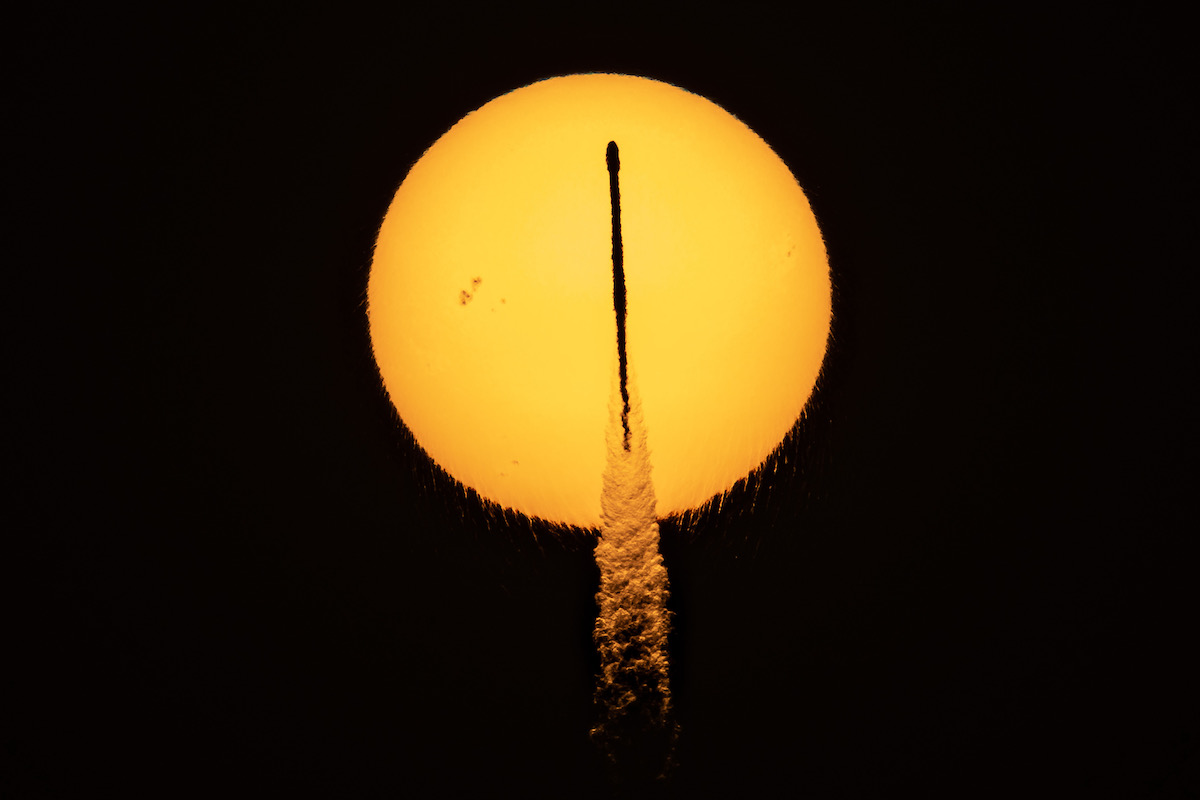
SpaceX’s third Starlink satellite delivery mission in five days departed Florida’s Space Coast just after sunrise Wednesday, adding 53 more mass-produced communications spacecraft to the company’s broadband internet network.
A Falcon 9 rocket climbed off its firing stand at the Kennedy Space Center at 6:59:40 a.m. EDT (1059:40 GMT) to kick off SpaceX’s 21st mission of the year, and the 14th launch of 2022 dedicated to deploying the Starlink network.
The launch originated from pad 39A at Kennedy, the historic site once used for liftoffs of NASA’s Apollo moon program, and now leased by SpaceX for crew and satellite deployment missions.
Nine Merlin 1D engines ignited to send the 229-foot-tall (70-meter) Falcon 9 rocket skyward, crossing through a golden sky a half-hour after sunrise on the Space Coast. Heading northeast, the kerosene-fueled engines throttled up to produce 1.7 million pounds of thrust for the first two-and-a-half minutes of the flight.
Then the booster stage detached to begin a descent toward SpaceX’s drone ship “A Shortfall of Gravitas” in the Atlantic Ocean. Titanium grid fins extended to give the cigar-shaped booster a bit of aerodynamic lift, helping steer the rocket toward its landing point east of Charleston, South Carolina.
A braking burn slowed the 15-story booster stage for a vertical landing. The reusable rocket stage, completing its fifth flight, covered the 400 miles between the launch and landing sites in about eight-and-a-half minutes.
Liftoff of SpaceX’s Falcon 9 rocket, the third mission in five days to deploy satellites for the privately-developed Starlink broadband network. https://t.co/4wyxyi0iiz pic.twitter.com/kh2YpbZ4Rp
— Spaceflight Now (@SpaceflightNow) May 18, 2022
The drone ship will return the booster back to Cape Canaveral for refurbishment. Meanwhile, the upper stage of the Falcon 9 rocket continued into orbit, achieving a speed of nearly 5 miles per second (8 kilometers per second).
Two burns by the second stage’s Merlin engine placed the 53 Starlink satellites into a near-circular orbit almost 200 miles (about 310 kilometers) above Earth. The orbital inclination was 53.2 degrees to the equator.
Retention devices released to allow the flat-packed Starlink satellites to fly free of the upper stage about an hour after liftoff, when the Falcon 9 was soaring south of Australia.
The upper stage was expected to perform an additional engine firing, allowing the spent rocket to deorbit itself for a destructive re-entry, ensuring it doesn’t become a piece of space junk.
The Starlink satellites, each more than a quarter ton in mass, were programmed to unfurl solar panels to generate power, then complete automated health checks before using on-board ion thrusters to maneuver to their operational altitude of 335 miles (540 kilometers). The orbit-raising will take weeks to months.

After Wednesday’s mission, designated Starlink 4-18, SpaceX has launched 2,653 Starlink satellites to date, including spacecraft that were decommissioned or suffered failures. More than 2,300 of those satellites are in orbit and functioning as of this week, according to a list maintained by Jonathan McDowell, an astrophysicist who closely tracks spaceflight activity.
The launch Wednesday morning marked the third Falcon 9 flight in five days, departing from all three of SpaceX’s active launch pads in California and Florida. Each of the three missions deployed 53 Starlink satellites.
A Falcon 9 rocket took off Friday from Vandenberg Space Force Base in California, then SpaceX launched another Falcon 9 Saturday from pad 40 Cape Canaveral Space Force Station. Wednesday’s mission lifted off from the Kennedy Space Center, a few miles north of pad 40.
The launch was the 47th SpaceX mission primarily dedicated to hauling Starlink satellites into orbit. SpaceX’s blistering pace of launches will continue next week with the next small satellite rideshare flight, known as Transporter 5, slated to lift off on a Falcon 9 rocket.
The Falcon 9’s first stage booster landed on the drone ship “A Shortfall of Gravitas” about 400 miles northeast of Cape Canaveral. This completes this booster’s fifth trip to space.
The upper stage arrived in a parking orbit with 53 Starlink satellites.https://t.co/4wyxyi0iiz pic.twitter.com/TMbttUdrbJ
— Spaceflight Now (@SpaceflightNow) May 18, 2022
Dozens of smallsats from external government and commercial customers will launch on the Transporter 5 mission. The launch from pad 40 is scheduled for next Wednesday, May 25, at approximately 2:30 p.m. EDT (1830 GMT). The Falcon 9 booster will return to Landing Zone 1 at Cape Canaveral for an onshore recovery.
SpaceX is slated to begin its June launch campaign with a Dragon cargo mission to the International Space Station, set for liftoff from the Kennedy Space Center on June 7. Additional SpaceX flights in June will launch the Nilesat 301 geostationary communications satellite for the Egyptian operator Nilesat, the German military’s SARah 1 radar observation spacecraft, the SES 22 television broadcasting payload, and more Starlink internet satellites.
Email the author.
Follow Stephen Clark on Twitter: @StephenClark1.
from Spaceflight Now https://ift.tt/30sFoyz
via World Space Info







0 comments:
Post a Comment